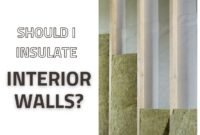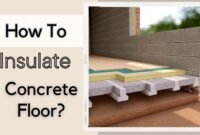Every homeowner understands the importance of a well-insulated home, but insulation in areas like the crawl space, especially with a dirt floor, often goes unnoticed. Insulating your crawl space, including the crawl space floor, walls, and ceiling, is essential for indoor air quality and overall home comfort.
Crawl space encapsulation, which involves using water-resistant material, can significantly enhance the effectiveness of this insulation.
Insulating your crawl space, particularly with a dirt floor, not only keeps your home warm but also contributes to significant energy savings and prevents moisture problems.
Properly insulating and encapsulating the crawl space helps maintain consistent indoor air quality and temperature, reducing the strain on heating and air conditioning systems. If you’ve been thinking about home improvements, starting with your crawl space is a smart way to enhance comfort and save money in the long run.
Best Insulation for Crawl Space With Dirt Floor: 4 Recommendations
Homeowners have several effective options for insulating crawl space with a dirt floor to consider, such as:
● Fiberglass
Fiberglass insulation, made from fine glass fibers, has long been a popular choice among homeowners for insulating crawl spaces. Its versatility allows it to be effectively used in various parts of the crawl space, including between floor joists and along crawl space walls.
However, when installing crawl space insulation, it’s important to ensure the material is properly fitted to prevent air leaks and maximize insulation efficiency. You’ll often find it in rolls or batts, ready to fit snugly between your crawl space studs, joists, and beams.

One of its primary advantages is its cost-effectiveness. However, for it to work efficiently, it must be installed meticulously, ensuring no gaps or spaces are left.
Read also: Benefits of Insulating Crawl Space With Dirt Floor
Gaps can compromise its insulating properties. While fiberglass effectively blocks cold, it’s worth noting that it doesn’t act as a moisture barrier. Additional measures might be needed if your crawl space is prone to dampness.
● Closed-Cell Spray Foam
Closed-cell spray foam is notable for its dense structure and impressive insulating properties. This type of insulation is particularly effective for crawl space encapsulation, as it adheres well to the crawl space floor and walls, forming a water-resistant barrier that protects against moisture and enhances thermal insulation. When applied, it expands, filling gaps, cracks, and crevices, ensuring a tight seal.
This type of insulation offers a high R-value, which means it’s highly resistant to heat flow. One of its standout features is its moisture resistance.
The dense nature of closed-cell foam makes it almost impervious to water, making it a great choice for crawl spaces exposed to moisture. While it might be pricier than other insulation types, its protection often justifies the cost.
● Open-Cell Spray Foam
Open-cell spray foam is another variant of spray foam insulation but with a lighter touch. It’s air-filled, giving it a spongy texture. This type of foam is less dense than its closed-cell counterpart, which means it’s not as effective as a moisture barrier.
However, it still offers commendable insulation properties. It’s essential to assess the moisture levels in your crawl space before opting for open-cell spray foam.
Read also: Where Not to Use Spray Foam Insulation ?
This might not be the best choice if there’s a water infiltration risk. On the upside, open-cell spray foam is generally more affordable than closed-cell foam.
● Rigid Foam Panel
Rigid foam panels are an excellent choice for providing high insulating value without adding much thickness to the crawl space ceiling or walls.
These panels are especially beneficial in crawl spaces with dirt floors, as they offer a continuous layer of insulation that is both effective and water-resistant, helping to maintain the integrity of the crawl space and improve the home’s overall energy efficiency. These panels are typically made from polystyrene, polyisocyanurate, or polyurethane.
They’re designed to reduce heat conduction, especially when placed continuously over frames or joists. Another advantage is their moisture resistance, making them suitable for damp crawl spaces.
Installation is straightforward, with panels often cut to fit the specific dimensions of the space. They provide a continuous insulating layer, ensuring minimal heat loss and maximum energy efficiency.
How do you pick one for your crawl space?
When selecting insulation for your crawl space, consider the following:
● Moisture Levels
Assess the moisture levels in your crawl space. If it’s prone to dampness, closed-cell spray foam or rigid foam panels might be more suitable.
● Overall Budget
While all the mentioned insulations are effective, their costs vary. Determine your budget and choose an option that offers the best value for your investment.
● Installation
Some insulation types, like spray foams, require professional installation. Ensure you factor in installation costs and the expertise needed when deciding.
● R-Value Measurement
The R-value measures the insulation’s resistance to heat flow. Higher R-values mean better insulating properties. Depending on your region’s climate, you might need higher or lower R-value insulation.
Selecting the best insulation for a crawl space with a dirt floor is crucial for a home’s energy efficiency and comfort. So, ensure a cozy living space by understanding the different insulation types to make an informed decision.


